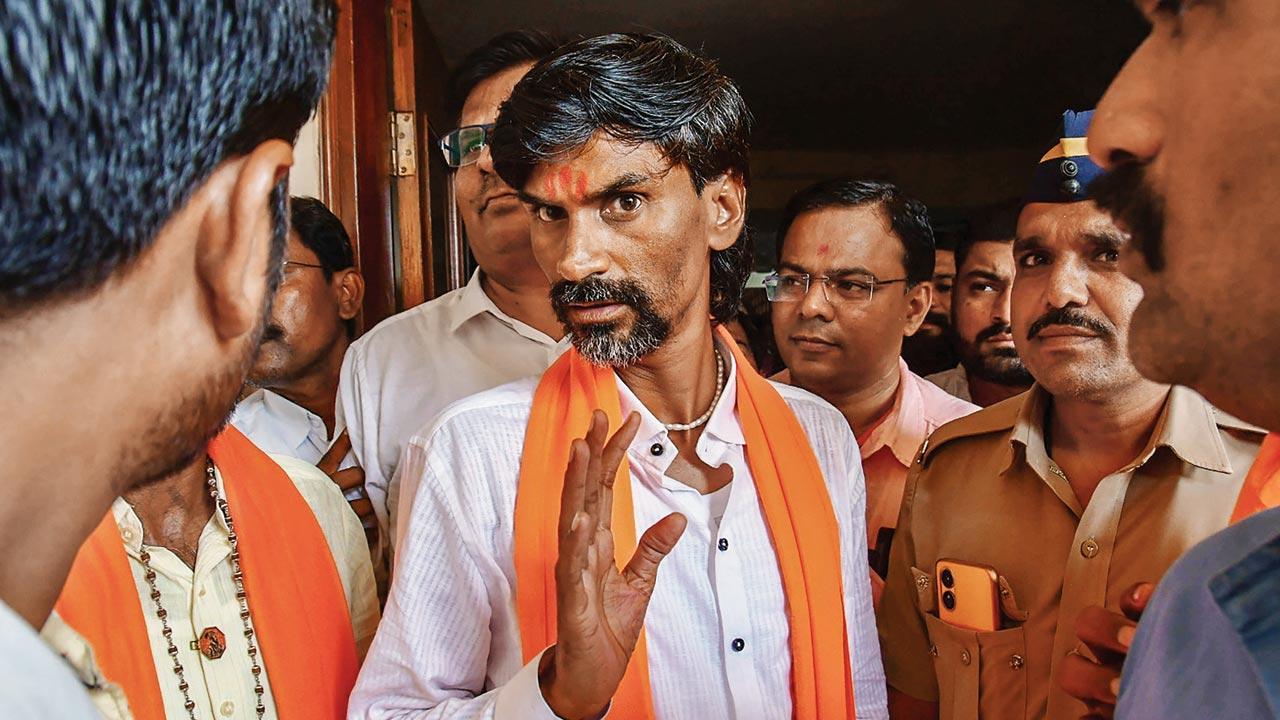Mounting agitation could affect ruling parties severely, especially if OBCs begin to feel government is against them

Activist Manoj Jarange Patil with supporters on October 19. Pic/PTI
The Maratha quota agitation has entered an intense phase, once again after five years when the community was granted reservation. This time around, the activism is more severe than ever. At least ten Marathas have ended their lives. Violence broke out in the streets in some places. Leaders cutting across the parties have been barred entry to hundreds of villages and towns. Activist Manoj Jarange Patil, a non-entity till the end of August this year, has assumed a prime role in influencing the community to intensify the agitation. Jarange Patil’s resumption of fast unto death has inspired many Marathas to take up the hunger agitation in their respective natives. The community is in no mood to backtrack.
ADVERTISEMENT
The Shinde government is on the edge. Apparently, it doesn’t have a resolution that can satisfy the largest community in the state. Yet, it will make another attempt to find a sustainable way through the special cabinet sub-committee meeting on Monday. In a nutshell, the government has been cornered. The Opposition is happy, because it did not have to face this kind of severe agitation when it was in power till recently and for decades before that. While it also faces the Maratha wrath, but not as intensely as the ruling parties, the Opposition has been trying to make the most of the Maratha anger as the current government struggles to woo the community.
Perceptions are being built to impress voters, though it is equally true that, the Opposition comprising the Shiv Sena splinters and the Congress, would not be able to concede immediately to the Maratha demand for an OBC status within the cap of 50 per cent reservation, even if it was in power or made the next government in the state and at the Centre.
There has been speculation about the ‘invisible hands’ supporting the Maratha agitation. Similar observations were made between 2015 and 2018, when Marathas pushed for a quota in a model and novel way of non-violence. The quota was first sanctioned in 2018 ahead of the Lok Sabha and Assembly elections. The elections are due next year. Then certain politicians, particularly Marathas from the Opposition and ruling parties, were tipped to be the patrons of the Maratha agitation. They have been named in similar discrete roles even now. However, Jarange Patil has dismissed speculations of outside support, calling the community’s protest a non-political one.
But of late, during his outburst, Jarange Patil has targeted a particular principal ruling party and its top leadership. It may be a strategic move to hit the government where it hurts most. In a way, it has been aiding the pre-poll mahol the Opposition proposes to create against the rulers, particularly the BJP. In its last regime, the BJP-led government had been able to avert a Gujarat-like Patel quota agitation in Maharashtra. But now, the Marathas have a Hardik Patel-like activist personality in Jarange Patil—the element that was missing in the 2015-18 phase of protest for independent quota. In 2023, the community has a face that has evoked an unprecedented following. Jarange Patil’s quota rally early this month in Antarwali Sarati had broken all records of mass attendance. The event has turned Jarange Patil into a legend—a position that the established Maratha and non-Maratha leaders envy. What happened to Hardik Patel later is another story. But Gujarat’s turn of events do get mentioned when the observers discuss Jarange Patil’s journey, in particular his future trajectory.
CM Shinde and DCMs Devendra Fadnavis and Ajit Pawar have appealed to Marathas to understand the intricacies involved in the quota process and urged them to desist from making a demand that is legally unfeasible. It’s a classic case of ‘once bitten twice shy’, because the Maratha quota was approved by the high court, but scrapped by the Supreme Court. A curative petition has been admitted by the apex court, but nobody is sure about the outcome.
Marathas have opted for a route that puts them in direct confrontation with the OBCs, who don’t want to share their quota. ‘Sharing is caring’ may be a quotable quote and a motivational call. But that doesn’t fit here in a complicated matter such as this. The confrontation, if carried forward, will also affect the ruling parties severely, especially if the OBCs find the government going against them. So, what the government can do at most is to buy more time to work on the legality, and meanwhile, lure Marathas and others with some attractive packages for their social and educational uplift (some promises have already been made and implemented). Monday’s meeting will reveal more about it. But looking at the scenarios, the vertical social split does not look like being narrowed, but appears to be getting wider day by day. A suitable condition for politics, indeed.
Dharmendra Jore is political editor, mid-day. He tweets @dharmendrajore
Send your feedback to mailbag@mid-day.com
 Subscribe today by clicking the link and stay updated with the latest news!" Click here!
Subscribe today by clicking the link and stay updated with the latest news!" Click here!







